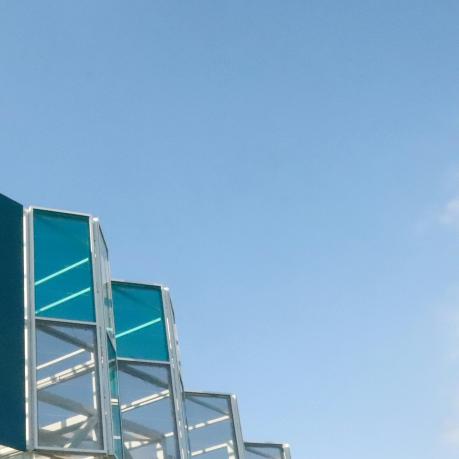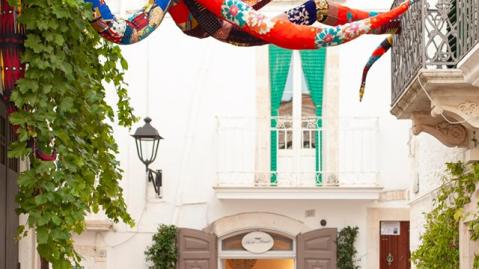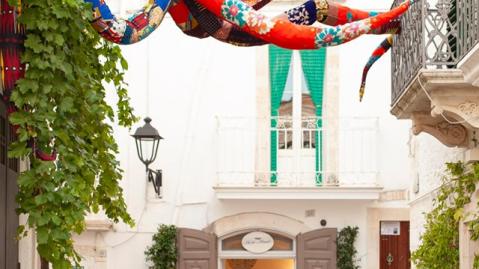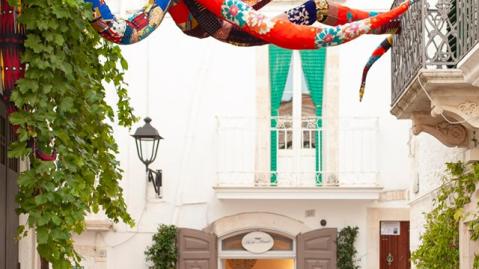
What to look for at COP29: Media Advisory
News publ. 11. Nov 2024
News publ. 16. May 2022

With the “New European Bauhaus” initiative, the EU wants to (re)design beautiful, sustainable and integrative places throughout Europe. Iva Radić-Capuani, an analyst in the field of urban transformation and municipal climate protection, explains adelphi’s role in selecting local projects.
The New European Bauhaus makes the European Green Deal a cultural, people-centric, positive and tangible experience for everyone. The initiative from the European Commission promotes the redesign and adaptation of cities across Europe. In a competition of the most creative ideas, inspiring, site-specific, transformative projects will be supported. These projects are to foster the three complementary values of the New European Bauhaus: sustainability, aesthetics and inclusion.
Twenty project ideas with a certain degree of maturity in their development are being sought. For example, the idea should be clear as to which infrastructure or which public space is to be converted.
Eligible projects include those that contribute to the New European Bauhaus in the following four areas:
The focus group are municipalities with less than 100,000 inhabitants. As these usually have less capacity to carry out such ambitious projects, the European Commission’s Directorate-General for Regional and Urban Policy (DG REGIO) seeks to target these municipalities in particular. The best project ideas will be supported by high-ranking experts from various disciplines towards their implementation.

The Italian winner of the New European Bauhaus Awards 2021: The Festival Esseri Urbani in Locorotondo, Italy, in the category " Mobilization of Culture, Arts and Communities".
Iva Radić-Capuani: When I first read the project description for the New European Bauhaus, I found the aspect of aesthetics particularly interesting. At adelphi we talk a lot about sustainability, which is of course important, but the fact that one of the core values of the project is aesthetics is just great. What is meant by aesthetics here is the importance of style beyond functionality, as well as the quality of the experience of places. The latter refers, among other things, to the sensory perception of our environment and our cities. I immediately had to think of our former colleague, Franziska Schreiber, who did a great project at adelphi a while ago. The project addressed the question of how we as emotional beings react to our cities and the significance of this knowledge for urban planning. Emotions play an important role in urban development and it’s great that this is being recognised more and more.
We are responsible for managing the entire application and project selection process. The most important part of our work was to break down the ideas we are looking for in such a way so that there is the greatest possible clarity about what is being sought. From this, everything else followed: from the questions in the application form to the call-website texts and the instructions for the evaluators.
Yes, indeed. The criteria should reflect the complex concept of the New European Bauhaus, but also exceed it. The projects we are looking for should also be able to meet the challenges of their region and benefit meaningfully from the support offered. That’s why we also ask about the project design, for example. Developing the many dimensions of a perfect project idea was a challenging task, but also a lot of fun!
The biggest challenge was operationalising the three values as there is an incredible number of initiatives under the umbrella of New European Bauhaus. Its basic principles are adopted, interpreted and constantly developed by the many actors in this broad movement. So our criteria had to reflect the concept appropriately but also work for our specific purposes. During this process, we worked very closely with the European Commission’s DG REGIO and Joint Research Centre (JRC).
For example, how do we operationalise aesthetics? It’s such a subjective thing, therefore it’s very important to ask the right questions. Something like: Does the project engage with the past and the socio-cultural present of a place? Does it take into account the cultural heritage and local uniqueness, the sense of place so to speak, and does it encourage people to be proud of their particular local context? Are the aesthetics used to make the place experienceable in a particular way and to convey the spirit of the New European Bauhaus on an emotional level?
You can read about all the criteria in the guidelines for applicants. Even if you are not a potential applicant, these guidelines are a good way to find out more about the concept of the New Euorpean Bauhaus.

The projects should also show how they provide benefits for the respective communities, how they bring added value to the population and region in the long term. So, the questions are: To what extent will life in the community be permanently improved? And does the impact of the project go beyond the administrative borders? It is also good if the project can be implemented at another location. They are also shortlisted if they involve many different interest groups, for example from civil society – especially socially weak and disadvantaged groups – science, the private sector or the media in planning and implementation. Finally, the project design is also decisive, whether it is promising, future-oriented and convincingly documented.
adelphi is primarily responsible for managing the selection process. The exact selection is made by experts from the fields of urban development, urban planning and architecture. They also ensure that the projects ambitiously seek to implement the three core values of the New European Bauhaus – i.e. sustainability, aesthetics and inclusion. With this lens, ultimately they select the best and most creative projects with the greatest potential.
There are two levels. First of all, there are the evaluators, experts within the consortium of all project partners. They create a shortlist of projects to be considered for selection. Then we go one step further: a jury made up of experts from the European Commission’s DG REGIO and JRC as well as external experts will make a final selection of 20 inspiring projects from this list.
Technical assistance will be offered to the selected projects. This means that a group of experts provides guidance on the project work. The first step is a needs analysis, i.e. what does the project actually require. Accordingly, the necessary expertise is made available. This includes, for example, technical advice, such as cost estimates, financing strategies or legal advice, or guidance on the involvement of interest groups – for example through stakeholder mapping or citizen participation.
Of course we can’t say anything about the current call yet, but great examples of completed projects can be found on the website of the New European Bauhaus Prizes. Projects can take part in this competition every year.
After the final projects have been selected, the second work package will begin in autumn. Then it will be decided which of the experts will be responsible for which project in order to provide targeted technical assistance. And at the end of the project, beautiful, sustainable and inclusive places across Europe will be celebrated.

The deadline for submitting project ideas for the New European Bauhaus Initiative has been extended to 30 May 2022 (14:00 CEST). Find out how to apply in this tutorial video.